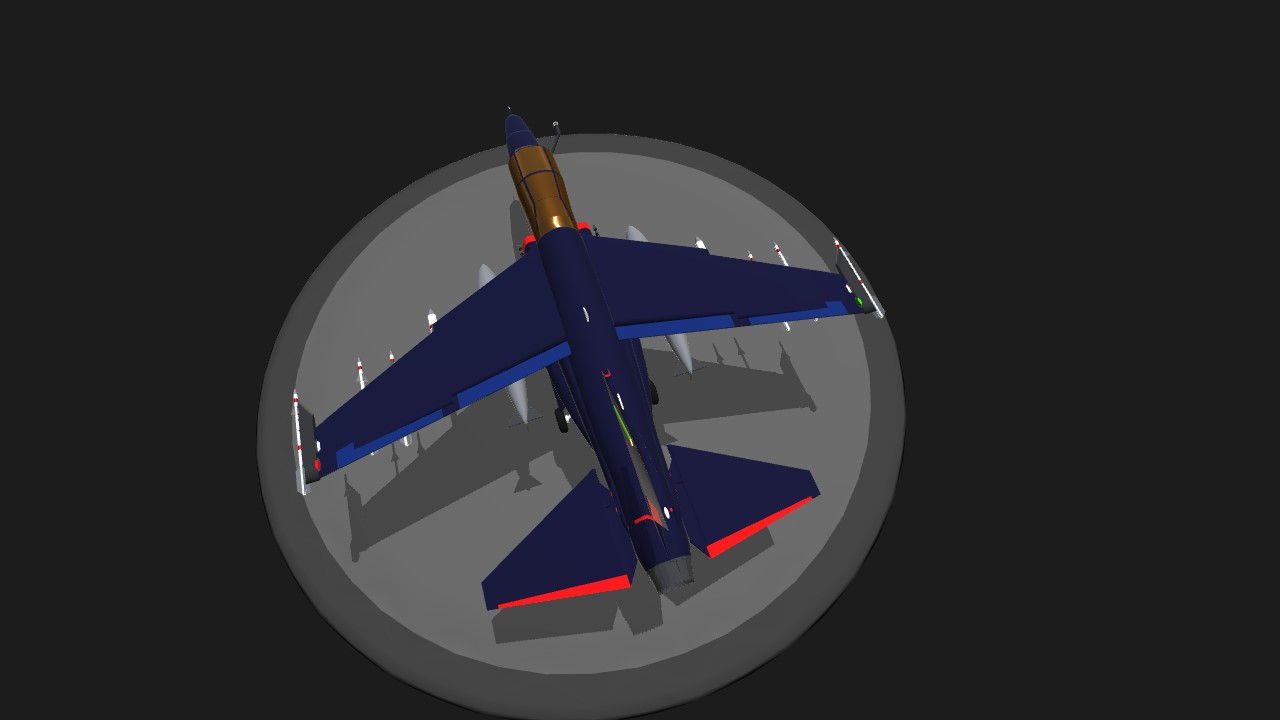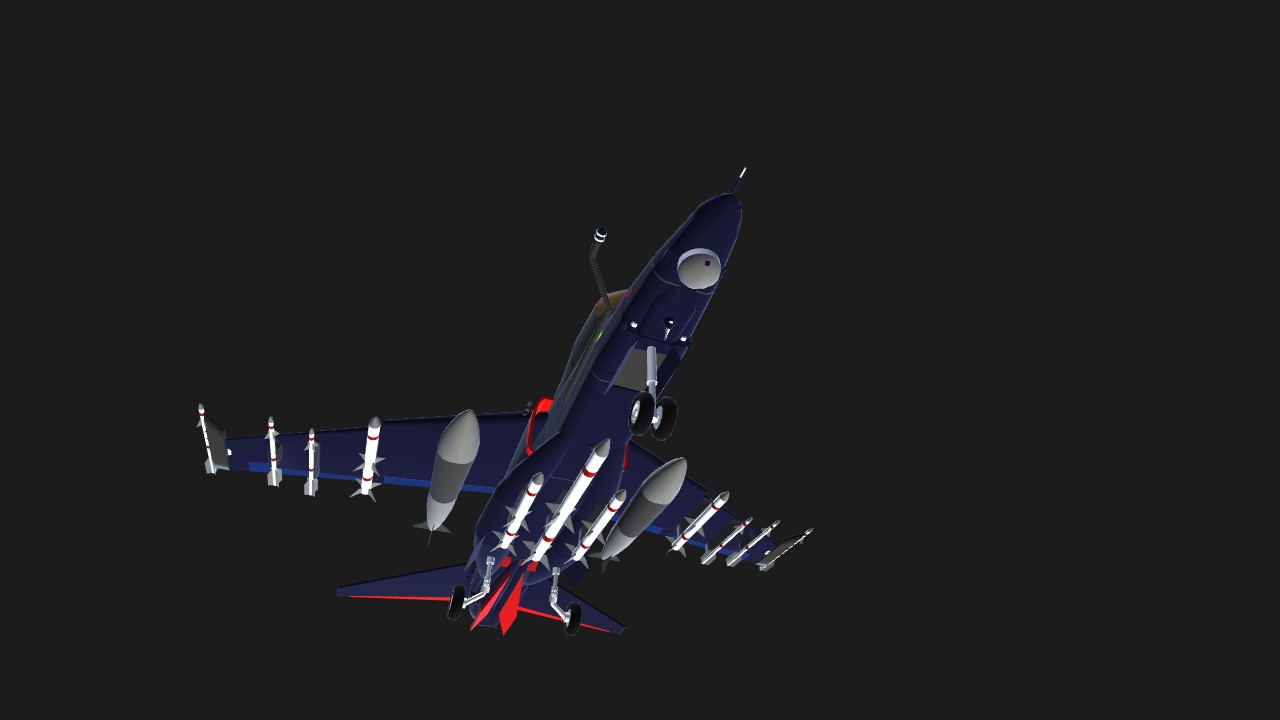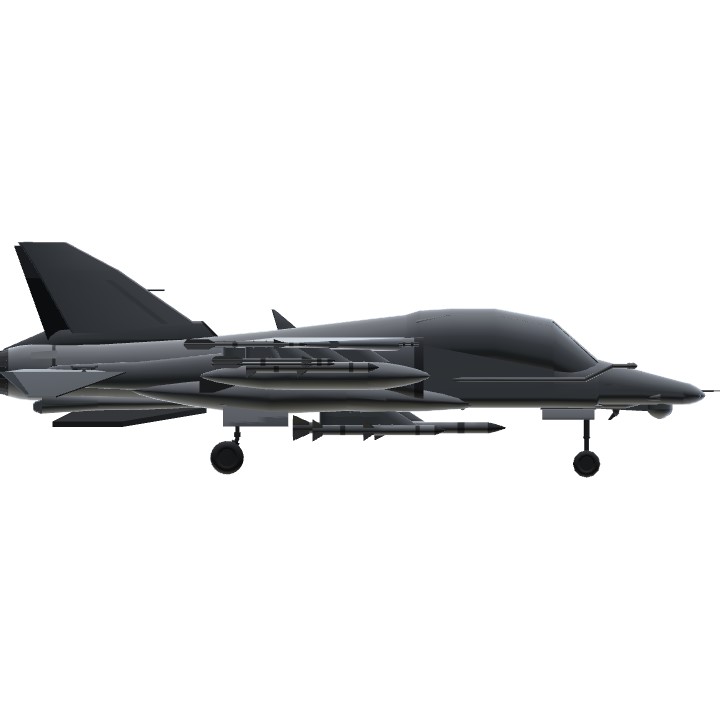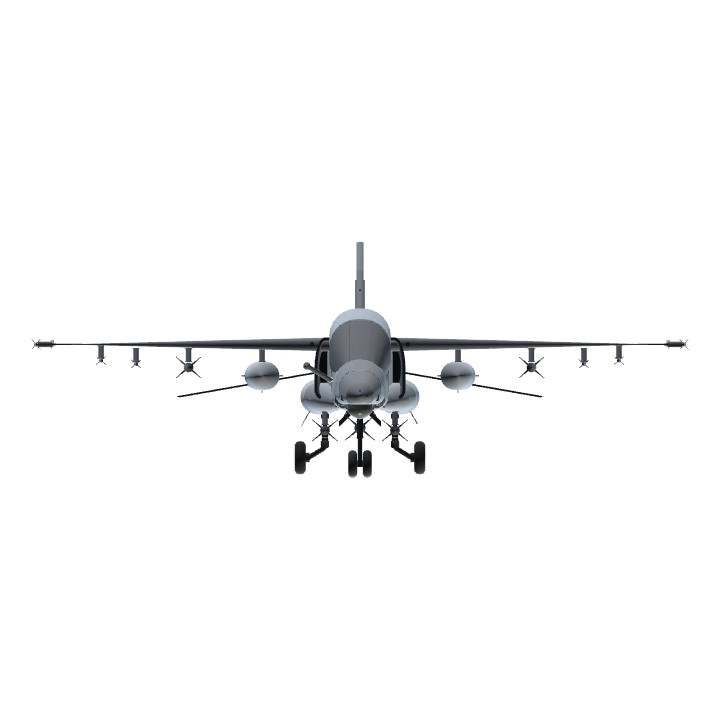Official entry for the Advanced Jet Trainer Challenge by @mikoyanster
-----------------------------------------------
CONTROLS
AG1: Droptanks Jettison
AG2: Airbrakes operation (for LDG on short runways)
AG3: Chute Deploy
AG4: Landing lights
AG5: Weapons Jettison
AG6: Air-refueling lights
AG7: Landing/Taxi lights
VTOL: down – Flaps operation
TRIM: down for nose-up
-------------------------------------------------------------
T/O PROCEDURE
-Trim tab FULL DOWN
-VTOL tab at MIDDLE
-Throttle 100%
Aircraft will rotate automatically at T/O speed
-Gear UP
-Trim tab RESET
---------------------------------------------------------------
LDG PROCEDURE
-Throttle 10-15% depends on weight
-Airspeed below 250mph
-Gear DOWN
-Trim tab gradually at FULL DOWN
-VTOL tab gradually FULL DOWN
-If going to land on short runways-AG2 for airbrakes
-Airspeed adjust at 160-180mph depending on weight
---------------------------------------------------------------------------
The T-9 Ocelot AJT (Advance Jet Trainer) is a modern, tandem twin-seat, single-engine, trainer aircraft designed for LIFT operations (Lead-In Fighter Training). It’s the official entry of HARPIA AERONAUTICS for the Advance Jet Trainer program. The T-9 design has been heavily based to the successful F-28C WarHawk lightweight attack aircraft produced by the same company for the Royal Krakabloan Air Force.
The T-9 Ocelot AJT has been designed having in mind the demands of modern fighter pilots’ training in an environment full of netcentric warfare and sensor fusing procedures. It’s a guaranteed training aircraft capable of preparing pilots for the next generation of fighter aircrafts at an affordable acquiring prics and at low maintance cost.
The T-9 Ocelot provides combat pilot training for front line fighters with high angle-of-attack capability. The aerodynamic design of the T-9 uses vortex lift to provide manoeuvrability and controllability at very high angle-of-attack using a fly-by-wire control system designed by BAE Systems alongside HARPIA DS.
The aircraft meets all the demands that have been posed from the regulating authorities of the AJT Program:
-Operational Gross Weight: 20.794lbs (weapons and droptanks included)
-Max. Speed at 20.000ft in Operational Gross Weight with 100% throttle: 1.160mph
-Max. Fuel (Droptanks included): 1.197 gal
-Number of parts: 175
-Weapons: 5 x Interceptor missiles, 6 x Guardian missiles and 2 x Miniguns
Armaments are carried on thirteen external store stations, eight of which are underwing, equipped with 2,000lb class ejector release units, three underside-fuselage stations and two wingtip stations for air-to-air missiles. The under-fuselage stations are capable of carrying avionics pods, air-to-ground and air-to-air weapons or even conformal fuel tanks.
The system data presentation and control functions of the stores management system use any one of the multifunction displays in both cockpits. Hands-on throttle and stick (HOTAS) controls are used to select the weapons. Weapon aiming is controlled by the central main processor, aiming data being presented to the pilots through the head-up display (HUD) or the helmet-mounted display (HMD).
The weapons carried include: MK82 500lb and MK83 1,000lb free-fall or retarded bombs set; rocket launchers; AIM-9X Sidewinder short-range air-to-air missiles; Raytheon AGM-65 Maverick and KH-29T air-to-ground anti-tank missiles; SPICE1000/2000 JDAM ammunition; AM-39 Exocet Blk III anti-ship missiles and almost all the NATO-certified ordnance and some Russian made weapons.
In the front section of the fuselage, under the radar assy is the Raytheon VALOR-808 reconnaissance turret with FLIR optronics elements and laser designator system, radar warning receiver and Elettronica ELT-55 electronic countermeasures management system. This avionics assembly has the codename "PhoenixNG" and is a patented system of HARPIA's avionics department alongside Raytheon.
For fighter trainer role, self-protection system functions and simulated tactical scenario threats are presented and monitored on the multifunction displays.
For operational roles, the aircraft is fitted with a radar warning receiver atop the rudder and active electronic countermeasures throught antennas all over the aircraft.
The avionics architecture is based on a dual-redundant MIL-STD-1553B digital data bus which has capacity for additional systems sucha as Link16. The communication suite includes a VHF/UHF transceiver and an information friend of foe (IFF) transponder. The navigation suite includes a laser gyro inertial navigation system with an embedded GPS receiver, and tactical air navigation (TACAN) and VHF omnidirectional radio ranging (VOR/IIS/MB).
A key feature of the T-9 Ocelot is the embedded tactical training system (ETTS). The ETTS is capable of emulating various equipment, such as radar, targeting pods, weapons, and electronic warfare systems; additionally, the ETTS can interface with various munitions and other equipment actually being carried on board.
The T-9 aircraft is also fitted with a fixed aerial refueling probe to extend the aircraft's operational range up to 1.000km (550nm).
Regarding the radar system, the T-9 incorporates a combined navigation/attack Doppler radar that simultaneously scans for targets and conducts fully automated terrain-following for low-level flight operations. The all-weather hands-off low-level flight is considered one of the core advantages of the T-9 Ocelot, giving training pilots a first view of modern navigation and targeting automated flight systems.
The radar system, designated as AN/APG-55 Cobra, it is designed for both air defence and air-to-ground operations; it is capable of continuously keeping track of up to 40 targets at ranges of up to 200 kilometres.
In addition, the T-9 Ocelot includes a wide-view bubble canopy for excellent visibility for both trainer and trainee and quite resistant at birdstrikes for speeds up to 400mph.
-----------------------------------------
Specifications
Spotlights
- mikoyanster 8.9 years ago
General Characteristics
- Predecessor Advanced Jet Trainer Challenge [FINISHED]
- Created On Windows
- Wingspan 38.2ft (11.6m)
- Length 42.2ft (12.9m)
- Height 13.8ft (4.2m)
- Empty Weight 12,758lbs (5,786kg)
- Loaded Weight 20,793lbs (9,431kg)
Performance
- Power/Weight Ratio 1.621
- Wing Loading 56.4lbs/ft2 (275.3kg/m2)
- Wing Area 368.8ft2 (34.3m2)
- Drag Points 6129
Parts
- Number of Parts 175
- Control Surfaces 7
- Performance Cost 784







Advanced Jet Trainer Challenge just begun!!
Updated results of the first phase. Check it now, clicking here!
1st Phase
Status :: Proceed to the next phase. Ok.
Maneuverability :: 8
Stability and control at low speed :: 9
Aesthetics and realistic model :: 8
Details and accessories :: 2
Extra points :: 0
Total :: 27
You are welcome. ;) @Dimkal
@KDS Thank u sir!
It's amazing! You get a upvote! :)
@mikoyanster Thank u alot! Hope it will succeed in ur testing fligths!
WOW!